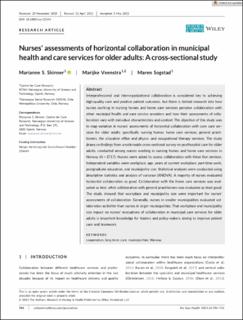| dc.contributor.author | Skinner, Marianne S. | |
| dc.contributor.author | Veenstra, Marijke | |
| dc.contributor.author | Sogstad, Maren | |
| dc.coverage.spatial | Norway | en_US |
| dc.date.accessioned | 2022-03-28T13:24:15Z | |
| dc.date.available | 2022-03-28T13:24:15Z | |
| dc.date.created | 2021-05-06T09:35:28Z | |
| dc.date.issued | 2021-05-25 | |
| dc.identifier.citation | Research in Nursing and Health. 2021, 44 (4), 704-714. | en_US |
| dc.identifier.issn | 0160-6891 | |
| dc.identifier.issn | 1098-240X | |
| dc.identifier.uri | https://hdl.handle.net/11250/2988085 | |
| dc.description.abstract | Interprofessional and interorganizational collaboration is considered key to achieving high‐quality care and positive patient outcomes, but there is limited research into how nurses working in nursing homes and home care services perceive collaboration with other municipal health and care service providers and how their assessments of collaboration vary with individual characteristics and context. The objective of this study was to map variation in nurses' assessments of horizontal collaboration with core care services for older adults, specifically nursing homes, home care services, general practitioners, the allocation office and physio‐ and occupational therapy services. The study draws on findings from a nationwide cross‐sectional survey on posthospital care for older adults, conducted among nurses working in nursing homes and home care services in Norway (N = 3717). Nurses were asked to assess collaboration with these five services. Independent variables were workplace, age, years at current workplace, part‐time work, postgraduate education, and municipality size. Statistical analyses were conducted using descriptive statistics and analysis of variance (ANOVA). A majority of nurses evaluated horizontal collaboration as good. Collaboration with the home care services was evaluated as best, while collaboration with general practitioners was evaluated as least good. The study showed that workplace and municipality size were important for nurses' assessments of collaboration. Generally, nurses in smaller municipalities evaluated collaboration as better than nurses in larger municipalities. That workplace and municipality size impact on nurses' evaluations of collaboration in municipal care services for older adults is important knowledge for leaders and policy‐makers aiming to improve patient care and teamwork. | en_US |
| dc.description.sponsorship | This study was supported by the Research Council of Norway, Grant Number 256644. | en_US |
| dc.language.iso | eng | en_US |
| dc.publisher | Wiley | en_US |
| dc.relation.ispartofseries | Research in Nursing and Health;Volume 44, Issue 4 | |
| dc.rights | Navngivelse 4.0 Internasjonal | * |
| dc.rights.uri | http://creativecommons.org/licenses/by/4.0/deed.no | * |
| dc.subject | Cooperation | en_US |
| dc.subject | Long‐term care | en_US |
| dc.subject | Municipalities | en_US |
| dc.subject | Norway | en_US |
| dc.title | Nurses' assessments of horizontal collaboration in municipal health and care services for older adults: A cross-sectional study | en_US |
| dc.type | Peer reviewed | en_US |
| dc.type | Journal article | en_US |
| dc.description.version | publishedVersion | en_US |
| dc.rights.holder | © 2021 The Authors | en_US |
| cristin.ispublished | true | |
| cristin.fulltext | original | |
| cristin.qualitycode | 2 | |
| dc.identifier.doi | https://doi.org/10.1002/nur.22144 | |
| dc.identifier.cristin | 1908373 | |
| dc.source.journal | Research in Nursing and Health | en_US |
| dc.source.volume | 44 | en_US |
| dc.source.issue | 4 | en_US |
| dc.source.pagenumber | 704-714 | en_US |
| dc.relation.project | Norges forskningsråd: 256644 | en_US |

